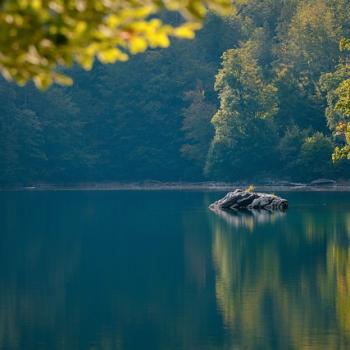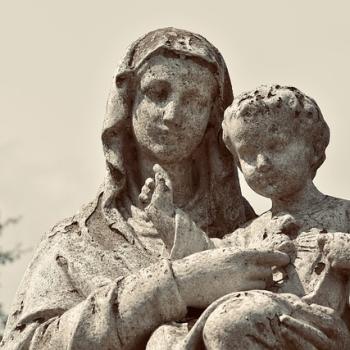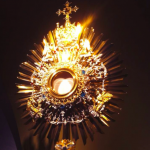It wasn’t even my great grandmother Anna Rita’s island; she was born in Franklinton. And it wasn’t Saint Patrick’s island. It was the island he’d been sold to as a slave, and came back to later as a missionary. I didn’t know whose island it was– whoever they were, I shared about half my DNA with them and none of my culture. But I was Irish, if only by blood.
After the litany, the altar boys picked up an enormous bier with a downright frightening, life-sized statue on it. The statue was of a gruff, white, suspiciously Irish-looking man with a long gray beard and a modern bishop’s cassock– it was meant to be Saint Patrick, but it could have been Gandalf or King Triton in a bishop’s cassock. He didn’t look like a father to me, but he was supposed to be my father, the patron of my ancestors.
It took six altar boys to carry the bier. One followed behind, holding a fire extinguisher, and then came several older boys with lit torches. The whole church followed them in procession outside, down the block and around and around the church, while a local band played bagpipes and big bass drums.
While they played, I had another sense of belonging. I marched in procession behind the scary bier and the flaming torches, somehow a part of a culture and tradition of which I knew nothing.
Later in the evening I would burst out crying for what seemed like no reason, but I always did that.
It was years later that I admitted the spiritual abuse that was going on around me. I ran away to the Ohio Valley to escape, and there I found another traditional Roman Catholic church with a communion rail, a choir loft and a great big statue of Saint Patrick– this statue was stuck in the facade. I ran into even more spiritual abuse; this town in the Ohio Valley is downright famous for it, and I seem to have a genius for always going to the wrong people for help. I’ve had a long exile here, belonging nowhere, bursting out crying for no reason, being a nuisance to the respectable people and the townies alike. I’m nothing at all like Saint Patrick or any other saint, but I did start to feel a kinship with him– spending all that time alone, in a place he didn’t belong with a language he didn’t speak, tending his master’s sheep with none but God for company. I asked him to be one of my fathers. He’s one of the people I prayed to for escape.
I’ve found my escape, in the Byzantine Catholic church. Somehow I was welcomed here. I felt like I belonged for more than a fleeting moment. I filled my home with icons all painted in Slavonic and Greek, languages I don’t know that have even less to do with me than Ireland and Saint Patrick’s Day, but they seem to suit me. An Orthodox friend reminded me that even Eastern Christians recognize Padraig as a saint.
He isn’t Irish, after all.
A week ago, I went sledding with my daughter. On the way home we saw a house all decorated with shamrocks and a sign, “Irish by blood, Irish by heart.”
I was inspired. I wanted to get out my paints and make a big sign for the window: “Irish by blood, Carpatho-Rusyn By heart.” But I couldn’t figure out how to write that in Cyrillic.
I don’t know if I’m Carpatho-Rusyn by heart. I am Irish by blood; I’m a child of God. I’ve spent a long time alone in a place I don’t belong, and ended up somewhere strange, where I stayed.
But Saint Patrick is certainly my father.













